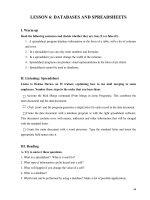Information Technology Assignment 2 Unit Business Intelligence.pdf
Bạn đang xem bản rút gọn của tài liệu. Xem và tải ngay bản đầy đủ của tài liệu tại đây (3.21 MB, 20 trang )
<span class="text_page_counter">Trang 1</span><div class="page_container" data-page="1">
<b> </b>
<b>BTEC FPT INTERNATIONAL COLLEGE </b>
<b>INFORMATION TECHNOLOGY ASSIGNMENT 2 UNIT: BUSINESS INTELLIGENCE</b>
<b> STUDENT NGUYEN TRINH ANH TUAN : CLASS : C05102 </b>
<b> STUDENT ID : BD00096 SUPERVISOR NGUYEN SI THIN : </b>
<b>Da Nang, November,2023 </b>
</div><span class="text_page_counter">Trang 2</span><div class="page_container" data-page="2"><b>ASSIGNMENT 2 FRONT SHEET </b>
<b>Qualification BTEC Level 4 HND Diploma in Comput g inUnit number and title Unit: BUSINESS INTELLIGENCE </b>
<b>Submission date 7/08/2023 <sup>Date received (1st </sup></b>
<b>submission) <sup>14 08</sup><sup>/ /2023 </sup></b>
<b>Re-submission date<sup>Date received (2nd </sup><sub>submission) </sub></b>
<b>Student name <sup>NGUYEN TRINH ANH </sup></b>
</div><span class="text_page_counter">Trang 3</span><div class="page_container" data-page="3">❒
<b>Summative Feedbacks: Resubmission Feedbacks:</b>❒
<b>Grade:Assessor Signature:Date:Internal Verifier’s Comments:</b>
<b>Signature & Date:</b>
</div><span class="text_page_counter">Trang 4</span><div class="page_container" data-page="4"><b>TABLE OF CONTENT </b>
Contents
I. How business intelligence tools can contribute to effective decision-making. ... 8
1. Business intelligence tools and technology. ... 8
a. Tablaeu. ... 8
b. MS Power BI. ... 9
c. Python. ... 10
2. How business intelligence tools can contribute to effective decision-making. ... 11
II. The legal issues involved in the secure exploitation of business intelligence ... 12
III. The examples of organizations that have used business intelligence tools to ... 13
enhance or improve operations. ... 13
IV. Conduct research to identify specific examples of organisations that have used business intelligence tools to enhance or improve operations ... 14
V.Evaluate how organisations could use business intelligence to extend their target audience and make them more competitive within the market, taking security legislation into consideration ... 17
CONCLUSION. ... 19
REFERENCES... 20
</div><span class="text_page_counter">Trang 5</span><div class="page_container" data-page="5"><b>LIST OF TABLES AND FIGURES </b>
Figure a-1Tableau’s logo ...9
Figure b-1Power BI’s logo...10
Figure c-1Python's logo. ...11
</div><span class="text_page_counter">Trang 6</span><div class="page_container" data-page="6"><b>LIST OF ACRONYM </b>
Business Intelligence BI
Artificial Intelligence AI
ML
</div><span class="text_page_counter">Trang 7</span><div class="page_container" data-page="7"><b>INTRODUCTION </b>
Business Intelligence (BI), also known as "Business Intelligence", is an important field of data management and analysis, aiming to support decisions and create useful information for businesses and organizations. With the rapid development of technology and enhanced data collection capabilities, BI has become an important tool that helps businesses better understand their operations, from tracking key performance indicators to predicting future trends.
The field combines methods, tools, and processes for collecting, storing, processing, and analyzing data from a variety of sources. BI systems not only help aggregate information from internal business data, but also integrate information from external sources such as social networks, markets, and geolocation data. The main goal of Business Intelligence is to provide insight into business operations, helping management make informed decisions based on accurate and reliable data. From optimizing marketing strategies to managing resources, BI brings breakthroughs in how businesses access and leverage information to achieve the best performance and compete in the marketplace.
</div><span class="text_page_counter">Trang 8</span><div class="page_container" data-page="8"><b>I. How business intelligence tools can contribute to effective decision-making. 1. Business intelligence tools and technology. </b>
Business intelligence revolves around data and its analysis. These tools aid in the aggregation and examination of data to facilitate enhanced future decision-making. Numerous software solutions in the business domain harness cutting-edge technologies like machine learning, predictive analysis, and planning. Tablaeu and MS Power BI stand as prime illustrations of such tools, proving highly potent in both managerial and IT domains. Likewise, microstrategy stands as another robust platform for data analysis and dashboard presentation. These platforms seamlessly integrate with spreadsheets and cloud computing, often necessitating minimal or no training. Their impact on enabling effective decision-making for countless enterprises is remarkable. Additionally, Python emerges as a pivotal technological asset, serving as a programming language that substantially supports business intelligence.
In the ensuing discourse, I shall elucidate the tangible ramifications of the aforementioned tools and technologies. By illustrating their constructive effects, I aim to underscore the advantages and bolstering roles they play in the decision-making process.
<b>a. Tablaeu. </b>
Tableau presents an array of substantial advantages for businesses, regardless of their scale. Through robust data visualization capabilities, entrepreneurs swiftly gain insights into their operational dynamics. The platform's expedient, interactive dashboards expedite the swift development and analysis of data, which subsequently informs decision-making processes. The manifold benefits of Tableau encompass:
• Rapid Analysis: Tableau's strength lies in its user-friendly interface, obviating the need for extensive programming proficiency. Any user granted access to data can promptly leverage the platform to extract meaningful value from it.
• User Autonomy: The simplicity of Tableau's setup is notable. Its desktop version, preferred by most users, is effortlessly installable and encompasses all the requisite functionalities for commencing and concluding data analysis.
</div><span class="text_page_counter">Trang 9</span><div class="page_container" data-page="9">• Visual Exploration: Tableau facilitates data exploration and analysis through visual aids such as color schemes, trend lines, charts, and graphs. The drag-and-drop approach eliminates the necessity for intricate scripting, streamlining the analytical process.
• Data Integration: Tableau empowers users to seamlessly integrate disparate data sets, including relational, semi-structured, and raw data sources, in real time. This occurs without incurring exorbitant upfront integration expenses. The intricate details of data storage mechanics need not concern users.
• Device Compatibility: Tableau's architecture is versatile, accommodating various devices and data flows. As such, users are relieved of the need to fret about specific hardware or software prerequisites for employing the platform.
• Real-Time Collaboration: The dynamic nature of Tableau enables on-the-fly data filtration, sorting, and discussion. Live dashboards can be embedded in platforms like SharePoint or Salesforce.
• Colleagues can subscribe to interactive dashboards, ensuring they access the latest data through simple web browser refreshes.
In essence, Tableau emerges as a potent ally, offering swift insights, user-driven analysis, and collaborative capabilities that substantively enhance the decision-making landscape for businesses of all sizes.
<b>b. MS Power BI. </b>
Power BI, a Microsoft offering, stands as a business analytics service that aspires to furnish interactive visualizations and business intelligence capabilities. Its interface is deliberately user-friendly, enabling end users to independently generate reports and dashboards. A constituent of the Microsoft Power Platform, Power BI's advantages encompass:
</div><span class="text_page_counter">Trang 10</span><div class="page_container" data-page="10">• Enhanced Decision-Making: Power BI elevates the precision of decision-making by offering comprehensive insights. Centralizing data minimizes the risk of oversight and omission. • Unveiling Hidden Truths: Even within intricate or voluminous datasets, Power BI uncovers
concealed truths. It orchestrates data organization, providing lucid overviews of accumulated information.
• User-Friendly Interface: Tailored for end-user ease, Power BI empowers individuals to craft visual reports and dashboards. This engenders a more coherent comprehension of data.
• Embedded Machine Learning: Power BI boasts integrated machine learning capabilities for trend recognition and predictive analysis. This proactive approach aids in staying ahead of the competitive curve.
• Personalization: High levels of personalization within Power BI expedite users' retrieval of after data.
sought-• Robust Security Measures: Power BI's robust security features facilitate the assignment of distinct access levels to both internal and external users. Regular updates ensure compliance with prevailing cybersecurity regulations and protocols.
• Seamless Integration: Through integration with renowned business tools Salesforce, SAP, Google —Analytics, MailChimp and Microsoft's own products such as Excel, Power BI eradicates data —dispersion across disparate sources.
In essence, Power BI emerges as a versatile ally, enriching decision-making with its insightful visualizations, user-driven interface, predictive capabilities, and stringent security measures, all while fostering harmonious integration with a range of business tools.
<b>c. Python. </b>
Python stands as an interpreted, high-level, and versatile programming language. Its design philosophy prioritizes code readability, notable for its reliance on significant indentation. The advantages of Python encompass:
• Excel Replacement: Python is progressively supplanting Excel spreadsheets due to its enhanced scalability, a feature that modern businesses necessitate. Excel serves adequately under specific conditions:
• For small datasets.
</div><span class="text_page_counter">Trang 11</span><div class="page_container" data-page="11">• When multi-layer processing and analysis are unnecessary. • When real-time data isn't imperative.
• However, in today's data-centric business landscape, these limitations are glaring. Python has emerged as a viable solution for data processing and management, empowering the creation of applications that facilitate comprehensive data comprehension.
• Data-Driven Solution: As businesses grapple with immense data volumes, Python addresses the challenges by enabling robust data processing and management applications. It empowers businesses to extract actionable insights from their data, aligning with the demands of the contemporary business ecosystem.
• Transition from Excel: Individuals heavily reliant on Excel for daily tasks should consider transitioning to Python for their data-centric applications. Python's versatility and capabilities offer a more efficient and comprehensive solution.
• Data Preprocessing: Python extends substantial support in data preprocessing. This entails filtering valuable data during evaluation, contributing to refined development and facilitating well-informed decision-making.
In sum, Python's prowess lies in its ability to transcend Excel's limitations, providing a scalable and potent solution for modern data-intensive business scenarios. It equips users to manage and process data effectively, ultimately fostering more informed decisions.
<small>Figure c-1Python's logo. </small>
<b>2. How business intelligence tools can contribute to effective decision-making. </b>
Business Intelligence (BI) encompasses the tools and processes used to analyze and interpret data, yielding a deeper comprehension of the market. It involves creating visualizations and analyses that streamline company operations. Historically, BI primarily aided enterprise users in understanding "what happened?" and "what's happening?" It delves into the details of events, participants, and future possibilities. While descriptive analysis serves its purpose, it's time to embrace advanced BI platforms. The significance of BI tools and technologies in decision-making is outlined below:
• Real-Time Insights: BI provides a historical and current perspective on all business activities. This real-time data empowers you to proactively access and analyze information, enabling a swift understanding of organizational challenges and efficient problem-solving.
</div><span class="text_page_counter">Trang 12</span><div class="page_container" data-page="12">• Data-Driven Decisions: In the modern business landscape, data-driven decision-making isn't optional—it's mandatory. BI tools excel in analyzing historical and present data, while also forecasting trends and future values. This predictive capability aids in selecting the most pragmatic and advantageous decisions.
• Visualized Understanding: BI tools and technologies play a pivotal role in visualizing and deriving statistics from data. Without them, data visualization and statistical analysis would be impractical. This capacity has a profound impact on the decision-making process.
• Benefits of BI Tools: Utilizing BI tools reaps several benefits: • Quick Responses: BI offers swift responses to business queries. • Real-Time Insights: Enables real-time queries with rapid navigation.
• Trend Identification: Spot evolving trends and seize cross-selling or up-selling opportunities. • Unified Budgeting: Integrates budgeting and planning processes into a centralized application. • Key Metrics: Provides key metrics reports for an -depth understanding of your business. in• Informed Decision-Making: Enhances decision-making by eliminating guesswork and basing
choices on evaluated reports.
In essence, BI tools offer a multifaceted advantage, spanning from real-time insights to predictive analysis, facilitating informed decision-making. By harnessing these tools, businesses are better positioned to navigate the complexities of their operations and seize opportunities for growth.
<b>II. The legal issues involved in the secure exploitation of business intelligence tools. </b>
Business intelligence (BI) has held a prominent role within law firms, historically serving as a library and research tool. It has traditionally been employed to capture a specific point in time and share static information on subjects like clients, industries, and attorneys through publications, dashboard-based presentations, and data processing. The evolving landscape of business intelligence now encompasses not only industry insights but also decision-making, historical analysis, and goal monitoring. However, as the needs of law firms and businesses become more intricate, challenges are shifting.
In the rapidly evolving realm of e-commerce, it's evident that the landscape is changing swiftly, pushing businesses to adapt. For instance, when an owner of a tourism company plans to market products or services online, they must consider the regulatory implications of e-commerce. Legal considerations come into play when safely utilizing business intelligence tools:
<b>1. Maintain privacy of clients. </b>
In an increasingly digital environment, protecting client confidentiality is paramount. Just as in the physical world, the confidential information of individuals should not be shared without proper authorization.
<b>2. Privacy. </b>
A significant amount of confidential information is accessible on the internet, and seemingly secure platforms like email or private accounts can inadvertently become sources of data leakage. Ethical and legal questions arise about the extent to which people are aware of how their accounts and actions are monitored.
</div><span class="text_page_counter">Trang 13</span><div class="page_container" data-page="13"><b>3. Digital Ownership. </b>
With the flow of information facilitated by digital media, challenges arise in defining ownership in the digital realm. Intellectual property and copyright laws struggle to keep up with the rapid sharing and copying of digital content.
<b>4. Data Gathering. </b>
In a world where online activities are continually monitored, concerns emerge about the boundaries of data gathering. Legislative actions designed to enhance national security have spurred debates about what information can be collected and for what purpose. This issue is mirrored on a smaller scale within businesses, where questions arise about employee data monitoring and transparency.
<b>5. Security Liability. </b>
While BI tools offer valuable insights, securing the collected data is crucial. As technology advances, enabling easy data access from various sources, a balance must be struck between accessibility and security. Developing systems to protect information from unauthorized access becomes imperative. In conclusion, the role of business intelligence has evolved from being a static data source to a dynamic tool that influences decision-making. However, with this evolution come legal considerations pertaining to client privacy, online privacy, digital ownership, data collection, and security liability. As businesses navigate this landscape, it's essential to strike a balance between harnessing the power of BI and upholding ethical and legal responsibilities.
<b>III. The examples of organizations that have used business intelligence tools to enhance or improve operations. </b>
Koodos, a pioneering startup incubated at Harvard Business School's Rock Center for Entrepreneurship, has harnessed the power of business intelligence tools to elevate and refine their operations in a notable manner. Their journey showcases how BI can drive innovation and effectiveness:
<b>1. Concept Validation: </b>
Koodos embarked on an endeavor to revolutionize content curation for Generation Z by utilizing generated data. This pioneering approach earned them accolades, with one venture capitalist drawing parallels between their concept and the "competitive messaging-based Pinterest for music."
<b>user-2. Initial Challenge: </b>
Koodos' business model hinges on deciphering intricate relationships within diverse datasets. Their initial experiment involved pairing emojis with music, wherein texting an emoji to a designated number yielded song recommendations from fellow users.
<b> 3. Early Struggles: </b>
Koodos faced hurdles in effectively evaluating the performance of their experiments. Absence of a robust BI tool made it arduous to analyze product performance, hindering their understanding of experiment outcomes.
<b>4. Business Intelligence's Role: </b>
Integration of a business intelligence tool revolutionized Koodos' data analysis capabilities, facilitating strategic decision-making.
</div>








